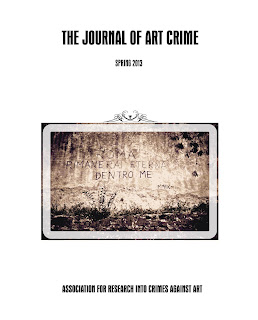Monday, August 05, 2013 -  art crime,illegal actors,illicit art trade,Transnational crime,Typology of interfaces
art crime,illegal actors,illicit art trade,Transnational crime,Typology of interfaces
 No comments
No comments
 art crime,illegal actors,illicit art trade,Transnational crime,Typology of interfaces
art crime,illegal actors,illicit art trade,Transnational crime,Typology of interfaces
 No comments
No comments
Edgar Tijhuis on "Legal and Illegal Actors around Art Crime: a Typology of Interfaces" (The Journal of Art Crime, Spring 2013)
 |
| Edgar Tijhuis |
This article discusses a number of criminological typological interfaces, and shows how they might apply to art crime. A number of interfaces from these typology could be used to understand particular activities within the illicit trade. Several interfaces commonly discussed by criminologists will turn out to be superfluous to the understanding the illicit art trade. The discussion of this typology in this article will show that seven of ten commonly-discussed interfaces could be used to understand the relationships between actors in the illicit art trade. These seven consisted of two antithetical interfaces and five symbiotic interfaces. The antithetical interfaces are the injurious and antagonistic interfaces; the symbiotic interfaces included the outsourcing, reciprocity, collaboration, co-option and synergy interface. Three interfaces seem superfluous, as far as the illicit art trade is concerned: the predatory, parasitical and funding interface.Edgar Tijhuis works at VU University as an associate professor and as researcher at the NSCR (Netherlands Institute for the Study of Crime and Law Enforcement), both in Amsterdam (The Netherlands). Furthermore he practices law at Pontius Lawyers and is an ARCA trustee.
Mr. Tijhuis introduces his article here:
Art crimes, like other crimes, in most cases ultimately depend on legal actors and the legitimate market. Without a legal market in art, or other goods, there would be no point in stealing them, at least in most cases. Exceptions to the rule are of course figures like Breitweiser or the infamous, but rarely found, rich collectors buying secretly from thieves or fences.
Despite the above, criminologists and others often describe and analyze crimes by focusing primarily on the criminals, and not the environment around them, including legal businesses, government agencies, etc. When this environment is mentioned, legal actors are often assumed to be either victims or actors with a minor stake in the crime. To shed more light on the role of legal actors and the interaction between legal and illegal, my PhD study specifically focused on the interfaces between legal and illegal actors, around transnational crime (Tijhuis: 2006). A typology of interfaces was refined, and a model was developed to understand the transformation from transnational crimes to legitimate activities. The study was based, in the first place, on a study of transnational crime in general, including all kinds of crimes ranging from, for example, arms trafficking, human trafficking, terrorism, to drug trafficking. Secondly, it was based on a thorough study of the illegal art and antiquities trade, and this typology and model was applied to this field of crime.
In this article, the interface typology will first be described. After that, the typology will first be described. After that, the typology will be applied to art crimes. The article is, in part, a reproduction of a portion of chapter 8 of the aforementioned PhD study, dealing with the illicit art trade (Tijhuis, 2006: 143-167).Mr. Tijhuis's article is continued in the ninth issue of The Journal of Art Crime, edited by Noah Charney and published by ARCA, available electronically (pdf) and in print via subscription and Amazon.com. The Associate Editor is Marc Balcells (ARCA '11), Graduate Teaching Fellow, Department of Political Science, John Jay College of Criminal Justice -- The City University of New York.








